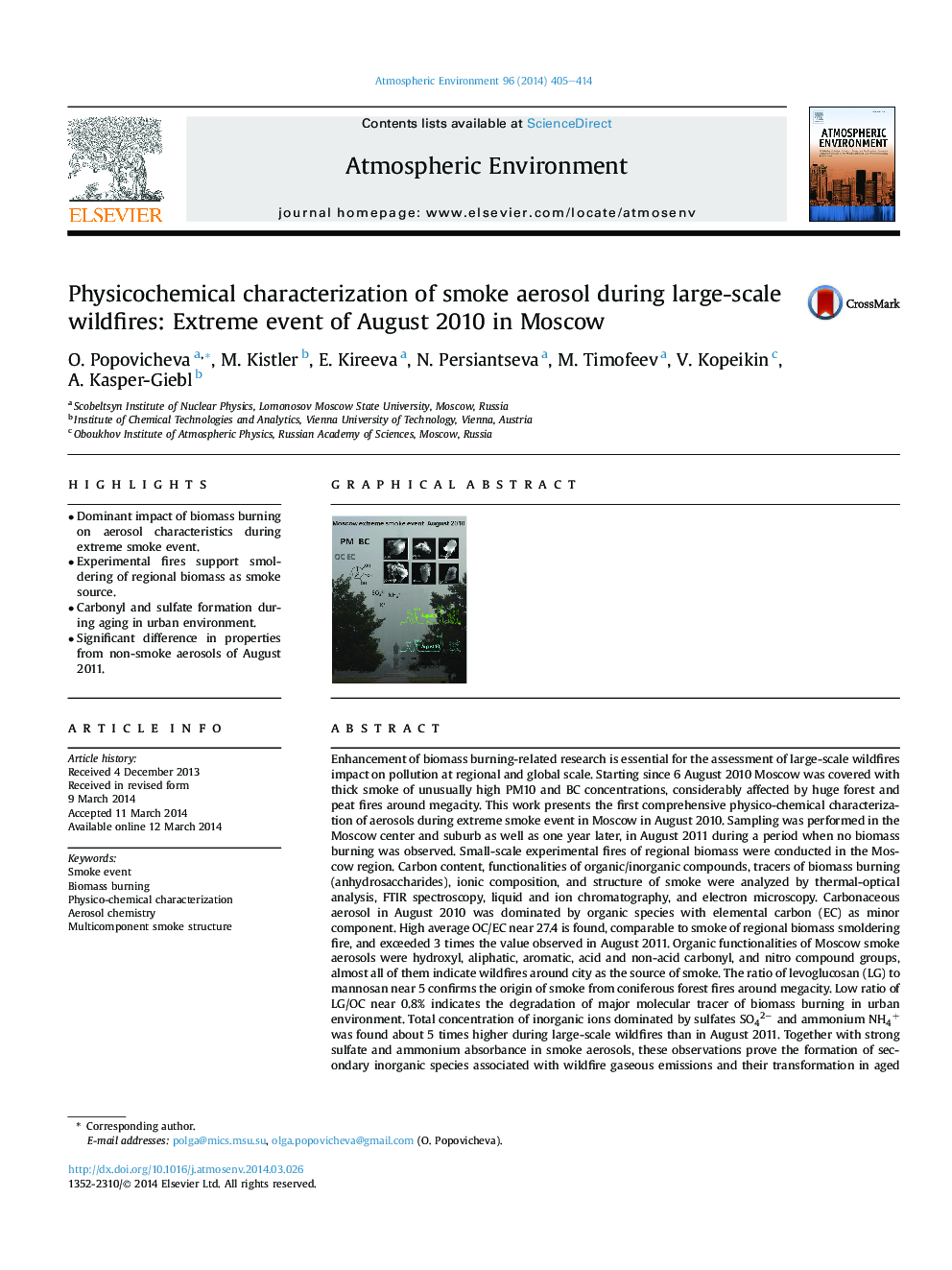| کد مقاله | کد نشریه | سال انتشار | مقاله انگلیسی | نسخه تمام متن |
|---|---|---|---|---|
| 6339985 | 1620375 | 2014 | 10 صفحه PDF | دانلود رایگان |
- Dominant impact of biomass burning on aerosol characteristics during extreme smoke event.
- Experimental fires support smoldering of regional biomass as smoke source.
- Carbonyl and sulfate formation during aging in urban environment.
- Significant difference in properties from non-smoke aerosols of August 2011.
Enhancement of biomass burning-related research is essential for the assessment of large-scale wildfires impact on pollution at regional and global scale. Starting since 6 August 2010 Moscow was covered with thick smoke of unusually high PM10 and BC concentrations, considerably affected by huge forest and peat fires around megacity. This work presents the first comprehensive physico-chemical characterization of aerosols during extreme smoke event in Moscow in August 2010. Sampling was performed in the Moscow center and suburb as well as one year later, in August 2011 during a period when no biomass burning was observed. Small-scale experimental fires of regional biomass were conducted in the Moscow region. Carbon content, functionalities of organic/inorganic compounds, tracers of biomass burning (anhydrosaccharides), ionic composition, and structure of smoke were analyzed by thermal-optical analysis, FTIR spectroscopy, liquid and ion chromatography, and electron microscopy. Carbonaceous aerosol in August 2010 was dominated by organic species with elemental carbon (EC) as minor component. High average OC/EC near 27.4 is found, comparable to smoke of regional biomass smoldering fire, and exceeded 3 times the value observed in August 2011. Organic functionalities of Moscow smoke aerosols were hydroxyl, aliphatic, aromatic, acid and non-acid carbonyl, and nitro compound groups, almost all of them indicate wildfires around city as the source of smoke. The ratio of levoglucosan (LG) to mannosan near 5 confirms the origin of smoke from coniferous forest fires around megacity. Low ratio of LG/OC near 0.8% indicates the degradation of major molecular tracer of biomass burning in urban environment. Total concentration of inorganic ions dominated by sulfates SO42â and ammonium NH4+ was found about 5 times higher during large-scale wildfires than in August 2011. Together with strong sulfate and ammonium absorbance in smoke aerosols, these observations prove the formation of secondary inorganic species associated with wildfire gaseous emissions and their transformation in aged smoke. Accumulation of carbonyl compounds during extreme smoke event in Moscow resulted from photochemical aging and secondary organic aerosol (SOA) formation in the urban atmosphere. The mixture of carbonaceous particles and dust revealed multicomponent structure of Moscow smoke aerosols, pointing the difference with non-smoke ambient aerosols. The abundance of group containing soot and tar balls approached at least a half of total aerosol concentration during extreme event, relating to elevated OC, EC and SOA. Fly ash groups contained calcium sulfates and carbonates from soil entrainment by hot air convection. Small-scale open fire experiments support the identification of specific chemical features of regional biomass burning and demonstrate the strong impact of large-scale wildfires on aerosol chemistry and air quality in highly polluted megacity.
88
Journal: Atmospheric Environment - Volume 96, October 2014, Pages 405-414
